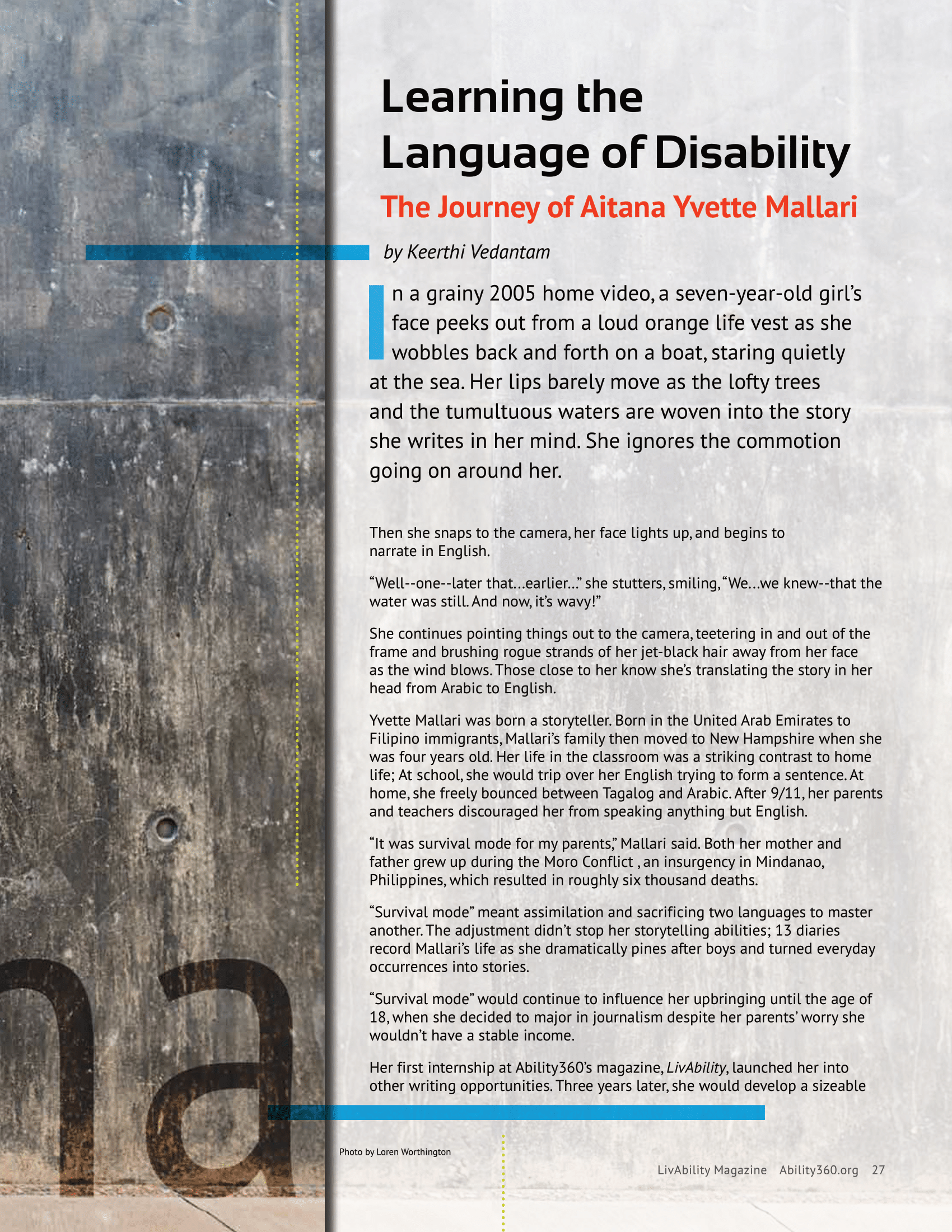
Learning the Language of Disability
The Journey of Aitana Yvette Mallari
Story by Keerthi Vedantam
Photos by Loren Worthington
Originally published in Livability Magazine
In a grainy 2005 home video, a seven-year-old girl’s face peeks out from a loud orange life vest as she wobbles back and forth on a boat, staring quietly at the sea. Her lips barely move as the lofty trees and the tumultuous waters are woven into the story she writes in her mind. She ignores the commotion going on around her.
Then she snaps to the camera, her face lights up, and begins to narrate in English.
“Well–one–later that…earlier…” she stutters, smiling, “We…we knew–that the water was still. And now, it’s wavy!”
She continues pointing things out to the camera, teetering in and out of the frame and brushing rogue strands of her jet-black hair away from her face as the wind blows. Those close to her know she’s translating the story in her head from Arabic to English.
Yvette Mallari was born a storyteller. Born in the United Arab Emirates to Filipino immigrants, Mallari’s family then moved to New Hampshire when she was four years old. Her life in the classroom was a striking contrast to home life; At school, she would trip over her English trying to form a sentence. At home, she freely bounced between Tagalog and Arabic. After 9/11, her parents and teachers discouraged her from speaking anything but English.
“It was survival mode for my parents,” Mallari said. Both her mother and father grew up during the Moro Conflict , an insurgency in Mindanao, Philippines, which resulted in roughly six thousand deaths.
“Survival mode” meant assimilation and sacrificing two languages to master another. The adjustment didn’t stop her storytelling abilities; 13 diaries record Mallari’s life as she dramatically pines after boys and turned everyday occurrences into stories.
“Survival mode” would continue to influence her upbringing until the age of 18, when she decided to major in journalism despite her parents’ worry she wouldn’t have a stable income.
Her first internship at Ability360’s magazine, LivAbility, launched her into other writing opportunities. Three years later, she would develop a sizeable writing portfolio writing for Modern Luxury Scottsdale, The Arizona Republic and Echo.
Though her byline has appeared in nearly every edition of LivAbility since her internship, the first introduction was rough.
How was your internship interview with Ability360? I ask. Mallari dips her head back and chugs her coffee before slamming down the plastic cup: “Terrible.” Mallari was the last of eight interviews the LivAbility team saw that day. She arrived late with a tender burn on her neck (hair-curling hazard) and clutching a small binder of articles she wrote. She sat down in front of Jennifer Longdon and Loren Worthington, who were managing the newly-formed marketing department at the time.
“I got their names wrong,” she admitted. “At one point I thought, ‘Maybe if I don’t talk, I’ll mess up less.’”
“She was a bit flustered, but I could see there was so much going on inside of her,” Longdon said, “There was a depth and a perceptiveness and an intellectual curiously that I found intriguing.”
Her first article was about chemical sensitivity, a complicated subject with many skeptics. Her story read more like a clinical essay.
“I didn’t know how to write about disability,” said Mallari. Disability in conversation is a whisper, not a shout, because it’s considered a taboo. “I had to ask a lot of questions I was not comfortable asking.”
Wrestling with her own comfort helped Mallari grow as a writer. Slowly, her profiles painted more and more intimate and nuanced details of disability through her words.
“I didn’t know how to write about disability,” said Mallari. Disability in conversation is a whisper, not a shout, because it’s considered a taboo. “I had to ask a lot of questions I was not comfortable asking.”
“I think what makes her a good storyteller is that she has this ability to pull a story out of somebody,” Worthington said. “She has a genuine curiosity to explain why a person is who they are.”
Her coverage, from art therapy to refugee conflicts, appeared on the pages of several LivAbility editions.
“To be a good storyteller requires some vulnerability on your part,” Longdon said. “Yvette has that vulnerability, that willingness to say, ‘I don’t know’ and to sit back and learn.”
It was a skill Mallari developed as a young child, from when she was seven years old on a boat and exploring her surroundings before telling her story to observing her classmates quietly (“I was an outsider,” she admitted) before engaging with them.
“I never liked how the media portrayed the Philippines, and that kind of transferred to how I worked here,” Mallari said. “This person is offering you a very personal glimpse into their reality. How do you showcase it in a way they deserve?”
Long after her internship ended, she continues to write for LivAbility Magazine while she works for Modern Luxury Scottsdale. Her photo, a young woman with striking hair and a steady gaze, is printed in every issue of LivAbility along with her byline. She has told the stories of others, but had never let someone write hers.
“I want us to write this story because I feel like in ten years from now, other people will recognize her unique skills,” Worthington said, grinning. “And I’ll be glad we did it first.”


